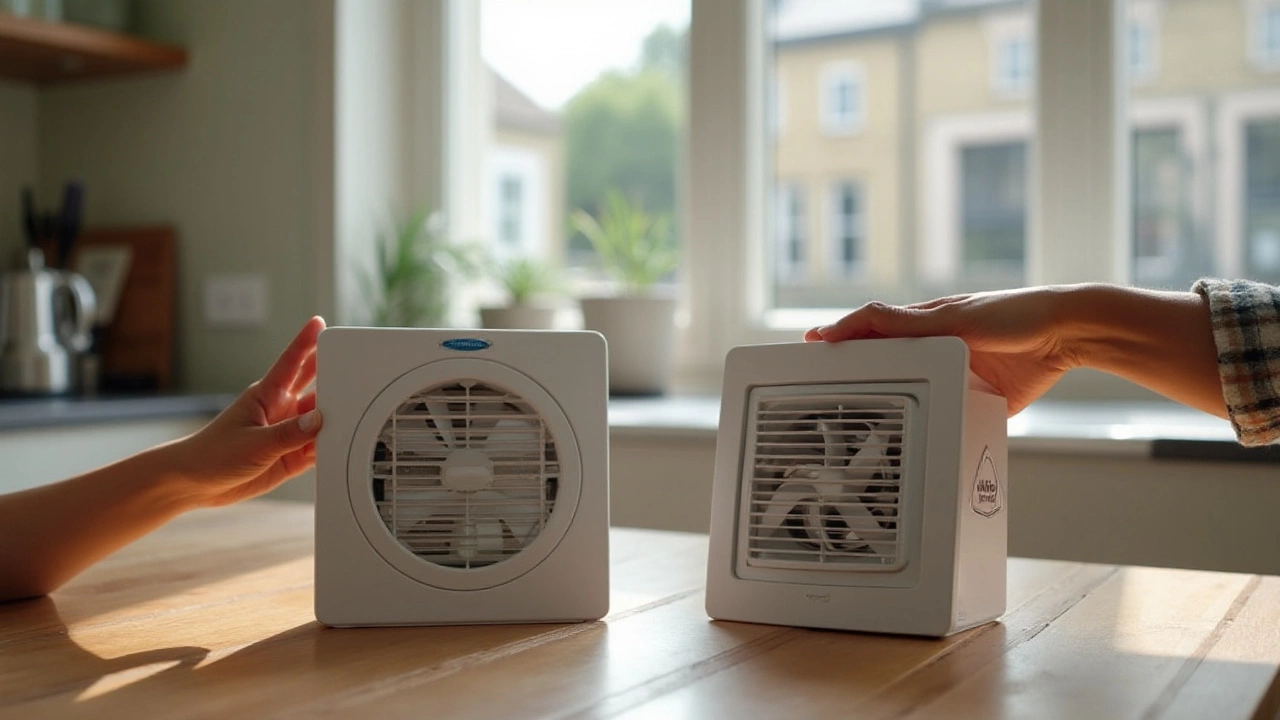Replacing an extractor fan might sound like a straightforward task, but it isn't always as simple as swapping one gadget for another. Extractor fans play a crucial role in maintaining good air quality and regulating moisture levels in places like kitchens and bathrooms. When your fan starts showing signs of wear or stops working altogether, the question arises: should you tackle it yourself or bring in an expert?
While do-it-yourself approaches can be tempting for the brave-hearted, they can also bring unforeseen challenges, especially if electrical work is involved. Each scenario presents its own set of variables, from the type of fan you have to the structure of your home. Learning when it's wise to reach out for help can save both time and headaches.
- Understanding Extractor Fans
- DIY vs Professional Installation
- Safety Concerns and Regulations
- Choosing the Right Extractor Fan
Understanding Extractor Fans
Extractor fans are essential for maintaining air quality in areas prone to moisture and odors, such as kitchens and bathrooms. They not only help keep your space comfortable but also play a critical role in preventing the build-up of mold and mildew by expelling humid air outside. It’s fascinating to note that these fans have become a ubiquitous presence in homes, yet many people often overlook their importance until a problem arises. Understanding extractor fans means knowing their purpose, how they work, and why they’re necessary for specific environments.
Originally designed for industrial uses, extractor fans have made their way into residential settings with technological advancements. At their core, these appliances draw air from a room and expel it outside, helping to regulate the indoor atmosphere. The mechanism involves a simple yet effective process where the fan's motor creates a suction effect, pulling stale and humid air along a ventilator path. It’s interesting to see that despite the simplicity of their operation, the role they play can significantly impact your home's air quality and energy efficiency.
An important aspect to consider is the type of extractor fan suited for different areas in your home. In kitchens, range hood fans, often integrated above cooktops, are designed to handle smoke and grease, whereas bathroom fans focus more on mitigating humidity levels. Not all extractor fans are constructed the same; some are tailored for high-volume air movement, and others for quieter operation. As needs differ, selecting the right fan is crucial to ensure that it handles the environmental conditions effectively. According to HomeAdvisor, a leading platform for connecting homeowners with service professionals, "Understanding the specific requirements of your space is key to choosing the most suitable fan."
When assessing which extractor fan is right for you, consider the fan's capacity, which refers to how much air it can move per hour. This is critical as it determines the fan's efficiency in managing air quality in your space. Many manufacturers provide cubic feet per minute (CFM) ratings, offering insight into the fan’s power. For instance, a kitchen might require a higher CFM compared to a bathroom due to the presence of cooking fumes and grease particles. This specificity underscores why a blanket solution rarely suffices when dealing with extractor fan replacement or installation.
The installation process also varies depending on the fan's design and location within the home. Inline fans, for example, are installed within the ductwork and are an excellent option when excessive noise can be an issue. On the other hand, wall-mounted and ceiling-mounted fans are directly fixed to the wall or ceiling, providing different advantages based on the position of the ductwork and the layout of the room. Understanding these differences can save time and investments when you consider DIY attempts or opt for professional help. This nuanced understanding of extractor fans not only aids in replacing them effectively but also ensures better decision-making in terms of your home’s environmental health.

DIY vs Professional Installation
When contemplating whether to replace an extractor fan yourself or hire an electrician, there are several factors to weigh in on. DIY enthusiasts often relish the challenge, driven by the satisfaction of completing a home improvement project on their own. However, it's crucial to acknowledge the skills and tools required for such a task. Installing an extractor fan involves dealing with electricity, which poses certain risks. If you've neglected to accurately assess your understanding of wiring and electrical systems, you might find yourself facing complications or even hazards you didn't anticipate when starting out. Drawing on reliable knowledge and adhering to safety guidelines is paramount for DIY success.
Professional installation, on the other hand, offers peace of mind that comes from knowing the job will be done right the first time. Electricians bring expertise and experience, ensuring that not only is the fan installed correctly, but also that it functions optimally. They are familiar with the latest safety standards and regulations, reducing the risk of future problems. As Mike Holmes, a well-regarded contractor, once remarked,
"The best projects are done by those who know what they’re doing, or those who have the good sense to ask for help when they don’t."Engaging a professional becomes especially critical if rewiring is necessary or if you're upgrading your system to a more sophisticated model.
Cost is often a decisive factor. DIY projects can save money upfront since you're only paying for the unit itself, not labor. However, if mistakes are made, corrective actions can end up costing more than if a professional was hired initially. In contrast, when you hire an electrician, while the expense might be higher at the onset, it often ensures a quicker installation and reduces the likelihood of malfunctions or setbacks. Consider it an investment in the longevity and performance of your extractor fan. The decision ultimately hinges on your confidence in your abilities and the complexity of the installation task at hand.
If you're leaning towards DIY, start by reading the manufacturer's manual thoroughly. This resource can offer vital insights into prerequisites and instructions specific to your fan model. However, for those facing uncertainty or if local building codes require licensed professionals for electrical work, opting for a professional installation could be the safer, more compliant choice. In many regions, there are legal stipulations surrounding which electrical tasks can be performed without a certified electrician. Ignoring these could result in penalties or void warranties.

Safety Concerns and Regulations
When it comes to replacing an extractor fan, safety should be your number one priority. While it might be tempting to dive into a DIY project, working with electricity always carries inherent risks. Understanding the safety concerns and regulations involved is crucial before attempting any kind of electrical installation. First and foremost, remember that even switching off the main power supply doesn't always guarantee complete safety. Residual currents can still pose a threat if the installation isn't handled correctly.
Electrical regulations vary depending on where you live, but many regions have strict codes governing the installation of electrical appliances in specific areas like kitchens and bathrooms. In the UK, for instance, Part P of the Building Regulations mandates that certain electrical work in a home is compliant with safety standards. This is important because non-compliance can not only lead to unsafe conditions but might also affect home insurance coverage.
Potential Hazards
While handling electrical installations, potential hazards include electric shocks and even fire risks, particularly when dealing with older wiring systems. A recent study showed that faulty electrical systems are one of the leading causes of domestic fires. Therefore, understanding the makeup of existing wiring and whether it complements modern extractor fan systems is vital. For this reason, many experts recommend hiring a qualified electrician, as they have the necessary experience and tools to navigate such complexities safely.
The Electrical Safety Foundation International reports that grounded and GFCI outlets in kitchens and bathrooms can reduce the risk of electric shocks dramatically.
Why Professionals Are Worth Considering
Professionals not only ensure compliance with safety standards but are also frequently updated with the latest regulations and best practices specific to extractor fan replacement. They bring meticulous care, such as ensuring adequate ventilation paths and making sure the extractor fan’s power demand isn't overloading circuits, both of which are critical to preventing overheating. Moreover, choosing a professional might even be a requirement for warranty validity on new extractor fan units. It's always a good decision to keep future maintenance and function in mind when considering who should handle your extractor fan replacement.
Despite the lure of potential savings and the rewarding feeling of DIY, when safety and regulations are at play, it's often prudent to consult an expert. However, if you're still keen to do it yourself, do thorough research, consult safety guides, and maybe even discuss your plans with an electrician to ensure you're not overlooking critical safety measures.

Choosing the Right Extractor Fan
Choosing the right extractor fan for your home is more than just a purchase; it's an investment in the comfort and safety of your living environment. An ideal fan should effectively remove moisture, odors, and airborne particles, ensuring good air quality in spaces like kitchens and bathrooms. The first step in your selection process should be understanding the airflow capacity of the fan. Airflow is usually measured in cubic feet per minute (CFM). It’s crucial to match this with the size of the room and its particular ventilation needs. For instance, in high-moisture areas like bathrooms filled with steamy showers, a fan with a higher CFM will be necessary compared to a smaller room that requires less ventilation.
Another factor to consider is the noise level of the fan, rated by sones. A noisy fan can be incredibly disruptive, especially in quiet evenings or early mornings. While it might seem insignificant, getting a quiet fan can significantly enhance the quality of your living space. Fans rated below 1 sone are typically considered very quiet, akin to the hush of a library, while those rated higher than 4 sones can resemble the chatter of a busy office. Reading reviews and product descriptions attentively helps when deciphering these ratings. Some units may offer advanced sound-dampening technology, which is a boon in maintaining a peaceful home environment.
Energy efficiency is another key consideration. Modern extractor fans might come with energy-saving features such as timers, humidity sensors, and low-wattage motors. These not only cut down on your energy bills but can also extend the lifespan of your fan by ensuring it operates only when necessary. Look for fans with an Energy Star rating, as these are certified to use less energy without compromising performance. Investing initially in an energy-efficient model might cost a bit more upfront, but the savings on electricity and potential repairs can make it worthwhile.
Installation context is also critical when selecting an extractor fan. Ceiling-mounted and wall-mounted fans serve different needs based on a room's architecture. If you're replacing an existing fan, matching the type exactly simplifies installation, particularly if you’re considering doing it yourself. When adding a fan to a space without one, consider the placement carefully to avoid long vent runs, which can reduce efficiency. In any case, whether for a kitchen or a bathroom, ensure that the fan is resistant to humidity and heat, especially given the kitchen's challenging environment.
Finally, aesthetics and features deserve a mention. Today’s extractor fans aren't just functional; they come in a variety of designs and finishes to suit your aesthetic preferences. From sleek, modern stainless-steel models to more understated designs, there's something out there to complement your home's decor. Some come with integrated lighting, adding an element of multifunctional design, which can be particularly useful in a bathroom setting. Details like these can create a seamless look without sacrificing functionality.
"The right extractor fan will contribute to a healthier home by maintaining optimum air quality," noted an article in Home Improvement Magazine, highlighting the importance of making an informed choice.

I am an expert in the services industry with a focus on appliance repair. My passion lies in understanding how things work and educating others in simple, engaging ways. This enthusiasm fuels my writing, where I delve into topics around appliance maintenance and troubleshooting. I aim to make these subjects clear and accessible to all readers.